Comparative Appraisal of Three Low-Cost GPS Speed Sensors with Different Data Update Frequencies
Abstract
:1. Introduction
2. Materials and Methods
2.1. GPS Speed Sensors
2.2. Data Acquisition (DAQ) System
2.3. Computer Program
2.4. Calibration of the Reference Speed Measurement System
2.5. Speed Measurement Tests
2.6. GPS Signal Quality
2.7. Data Analysis
3. Results
3.1. Speed Measurement Errors at Increasing Speeds
3.2. Speed Measurement Errors at Constant Speeds
3.3. Speed Measurement Errors at Decreasing Speeds
3.4. Percent Speed Measurement Errors
3.5. Relationship between the Speed Measurement Errors and the Acceleration Levels
3.6. Statistical Data Analysis Results
4. Discussion
5. Conclusions
Author Contributions
Funding
Institutional Review Board Statement
Informed Consent Statement
Acknowledgments
Conflicts of Interest
References
- Novatel. GNSS Velocity Solutions. Available online: www.novatel.com/solutions/velocity (accessed on 15 June 2021).
- Keskin, M.; Akkamis, M.; Sekerli, Y.E. An overview of GNSS and GPS based velocity measurement in comparison to other techniques. In Proceedings of the International Conference on Energy Research, Alanya, Turkey, 31 October–2 November 2018; pp. 392–404. [Google Scholar]
- Keskin, M.; Han, Y.J.; Dodd, R.B. A review of yield monitoring instrumentation applied to the combine harvesters for precision agriculture purposes. In Proceedings of the 7th International Congress on Agricultural Mechanization and Energy Proceedings, Adana, Turkey, 26–27 May 1999; pp. 426–431. [Google Scholar]
- Ess, D.; Morgan, M. The Precision-Farming Guide for Agriculturists, 2nd ed.; John Deere Publishing: Moline, IL, USA, 2003. [Google Scholar]
- Keskin, M.; Karanlik, S.; Görücü Keskin, S.; Soysal, Y. Utilization of color parameters to estimate moisture content and nutrient levels of peanut leaves. Turk. J. Agric. For. 2013, 37, 604–612. [Google Scholar] [CrossRef]
- Vishwanathan, R.; Weckler, P.R.; Solie, J.B.; Stone, M.L. Evaluation of ground speed sensing devices under varying ground surface conditions. In Proceedings of the ASAE Annual International Meeting, Tampa, FL, USA, 17–20 July 2005; pp. 1–11. [Google Scholar]
- Mullenix, D.; Fulton, J.; Winstead, A. Using GPS as a source for ground speed radar inputs. In Precision Agriculture Series Timely Information; Alabama Cooperative Extension System Publication: Auburn, AL, USA, 2010; p. 2. [Google Scholar]
- Khalilian, A.; Hale, S.A.; Hood, C.H.; Garner, T.H.; Dodd, R.B. Comparison of four ground speed measurement techniques. In Proceedings of the ASAE International Summer Meeting, Qubec City, QC, Canada, 25–28 June 1989. Paper no: 89-1040. [Google Scholar]
- Lackas, G.M.; Grisso, R.D.; Yasin, M.; Bashford, L.L. Portable data acquisition system for measuring energy requirements of soil-engaging implements. Comput. Electron. Agric. 1991, 5, 285–296. [Google Scholar] [CrossRef]
- Zhixiong, L.; Xuefeng, B.; Yiguan, L.; Jaingxue, C.; Yang, L. Wheel slip measurement in 4WD tractor based on LABVIEW. Int. J. Autom. Control Eng. 2013, 2, 113–119. [Google Scholar]
- Keskin, M.; Say, S.M. Feasibility of low-cost GPS receivers for ground speed measurement. Comput. Electron. Agric. 2006, 1, 36–43. [Google Scholar] [CrossRef]
- Doğan, S.; Temiz, M.S.; Külür, S. Real Time Speed Estimation of Moving Vehicles from Side View Images from an Uncalibrated Video Camera. Sensors 2010, 10, 4805–4824. [Google Scholar] [CrossRef] [PubMed] [Green Version]
- Freda, P.; Angrisano, A.; Gaglione, S.; Troisi, S. Time-differenced carrier phases technique for precise GNSS velocity estimation. GPS Solut. 2015, 19, 335–341. [Google Scholar] [CrossRef]
- Gaglione, S. How does a GNSS receiver estimate velocity? Inside GNSS 2015, 16, 38–41. [Google Scholar]
- Dyukov, A.; Suelynn, C.; Silcock, D. Accuracy of speed measurements using GNSS in challenging environments. Asian J. Appl. Sci. 2015, 3, 794–811. [Google Scholar]
- Dyukov, A. Development of an electronic speed measurement system for evaluating the accuracy of GNSS receivers and statistical analysis of their performance in speed measurements. Univers. J. Electr. Electron. Eng. 2016, 4, 33–50. [Google Scholar] [CrossRef] [Green Version]
- Say, S.M.; Keskin, M.; Sehri, M.; Sekerli, Y.E. Adoption of precision agriculture technologies in developed and developing countries. In Proceedings of the International Science and Technology Conference, Berlin, Germany, 17–19 July 2017; pp. 41–49. [Google Scholar]
- Barnes, A.; De Soto, I.; Eory, V.; Beck, B.; Balafoutis, A.; Sanchez, B.; Vangeyte, J.; Fountas, S.; Van der Wal, T.; Gomez-Barbero, M. Influencing factors and incentives on the intention to adopt precision agricultural technologies within arable farming systems. Environ. Sci. Policy 2019, 93, 66–74. [Google Scholar] [CrossRef]
- Akkamis, M. Determination of the Performance of GPS Speed Sensors with Different Data Update Frequencies. Master’s Thesis, Hatay Mustafa Kemal University, Antakya, Hatay, Turkey, 2018. (In Turkish with Abstract in English). [Google Scholar]
- Jeffrey, C. An Introduction to GNSS: GPS, GLONASS, Galileo and other Global Navigation Satellite Systems, 1st ed.; NovAtel Inc.: Calgary, AB, Canada, 2010. [Google Scholar]
- Witte, T.H.; Wilson, A.M. Accuracy of non-differential GPS for the determination of speed over ground. J. Biomech. 2004, 37, 1891–1898. [Google Scholar] [CrossRef] [PubMed]
- Koc, A.B.; Koc, C.; Yurtlu, Y.B.; Vatandas, M. Static and dynamic tests of a low-cost GPS receiver. In Proceedings of the 23rd National Mechanization Congress, Canakkale, Turkey, 6–8 September 2006; pp. 277–282. [Google Scholar]
- Zhao, X.; Carling, K.; Hakansson, J. Reliability of GPS based traffic data: An experimental evaluation. Available online: www.diva-portal.org/smash/get/diva2:756062/FULLTEXT03.pdf (accessed on 15 June 2021).
- Beato, M.; Bartolini, D.; Ghia, G.; Zamparo, P. Accuracy of a 10 Hz GPS unit in measuring shuttle velocity performed at different speeds and distances (5–20 M). J. Hum. Kinet. 2016, 54, 15–22. [Google Scholar] [CrossRef] [PubMed] [Green Version]
- Fulton, J.; Darr, M.; Taylor, R.; Shearer, S. Proper implementation of precision agricultural technologies for conducting on-farm research. In Proceedings of the 10th International Conference on Precision Agriculture, Monticello, IL, USA, 18–21 July 2010. [Google Scholar]
- Keskin, M.; Sekerli, Y.E.; Kahraman, S. Performance of two low-cost GPS receivers for ground speed measurement under varying speed conditions. Precis. Agric. 2017, 18, 264–277. [Google Scholar] [CrossRef]
- Al-Gaadi, K.A. Testing the accuracy of autonomous GPS in ground speed measurement. J. Appl. Sci. 2005, 5, 1518–1522. [Google Scholar] [CrossRef]
- Supej, M.; Cuk, I. Comparison of global navigation satellite system devices on speed tracking in road (Tran) SPORT applications. Sensors 2014, 14, 23490–23508. [Google Scholar] [CrossRef] [PubMed] [Green Version]
- Gloersen, O.; Kocbach, J.; Gilgien, M. Tracking performance in endurance racing sports: Evaluation of the accuracy offered by three commercial GNSS receivers aimed at the sports market. Front. Physiol. 2018, 9, 1425. [Google Scholar] [CrossRef] [PubMed] [Green Version]
- Fu, W.; Shupeng, H.; Changhai, L.; You, L.; Shuxia, G.; Junxiong, Z. Development and test of GNSS/IMU-based speed measurement device for agricultural machinery. In Computer and Computing Technologies in Agriculture XI; Li, D., Zhao, C., Eds.; Springer: Cham, Switzerland, 2019; pp. 440–451. [Google Scholar] [CrossRef] [Green Version]
- Zheng, K.; Tang, L. Performance assessment of BDS and GPS/BDS velocity estimation with stand-alone receiver. J. Navig. 2016, 69, 869–882. [Google Scholar] [CrossRef] [Green Version]
- Dong, Y.; Wang, D.; Zhang, L.; Li, Q.; Wu, J. Tightly coupled GNSS/INS integration with robust sequential Kalman filter for accurate vehicular navigation. Sensors 2020, 20, 561. [Google Scholar] [CrossRef] [PubMed] [Green Version]
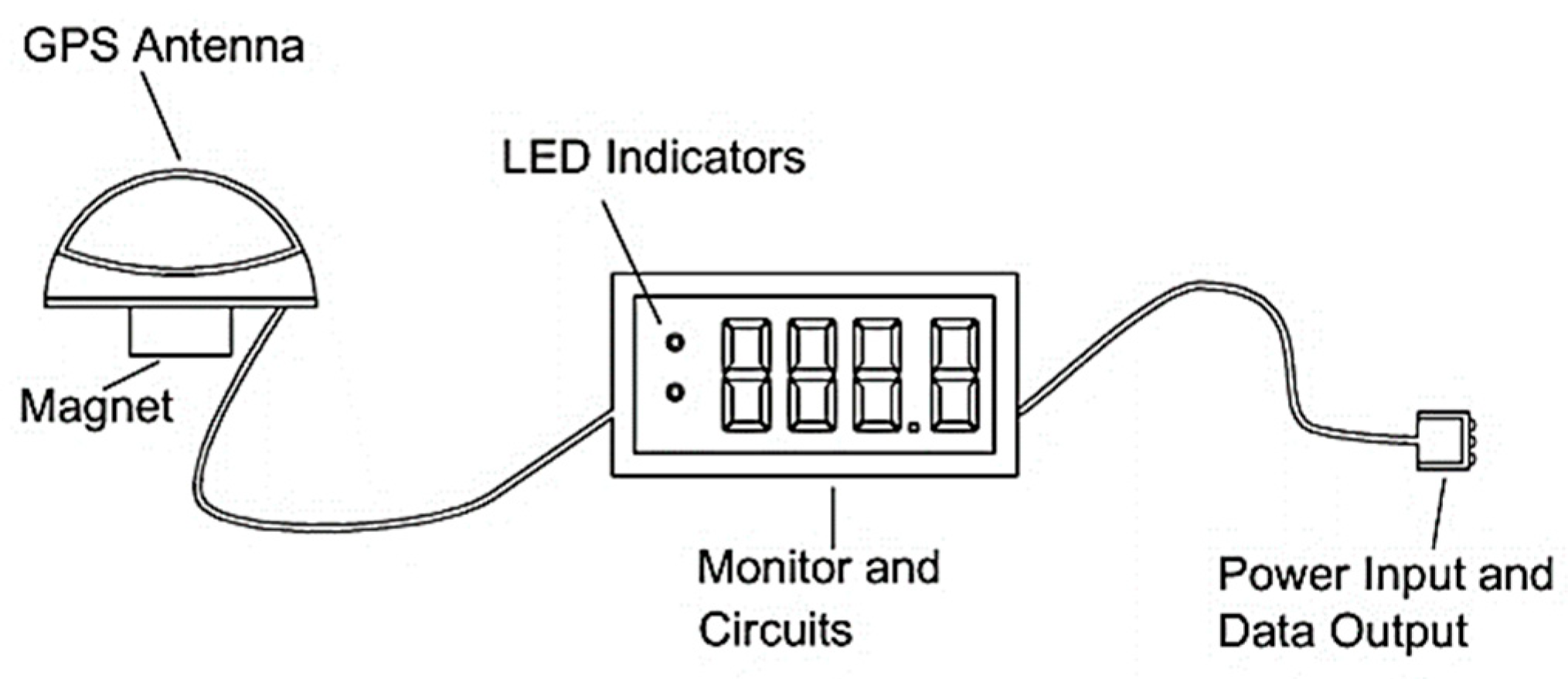
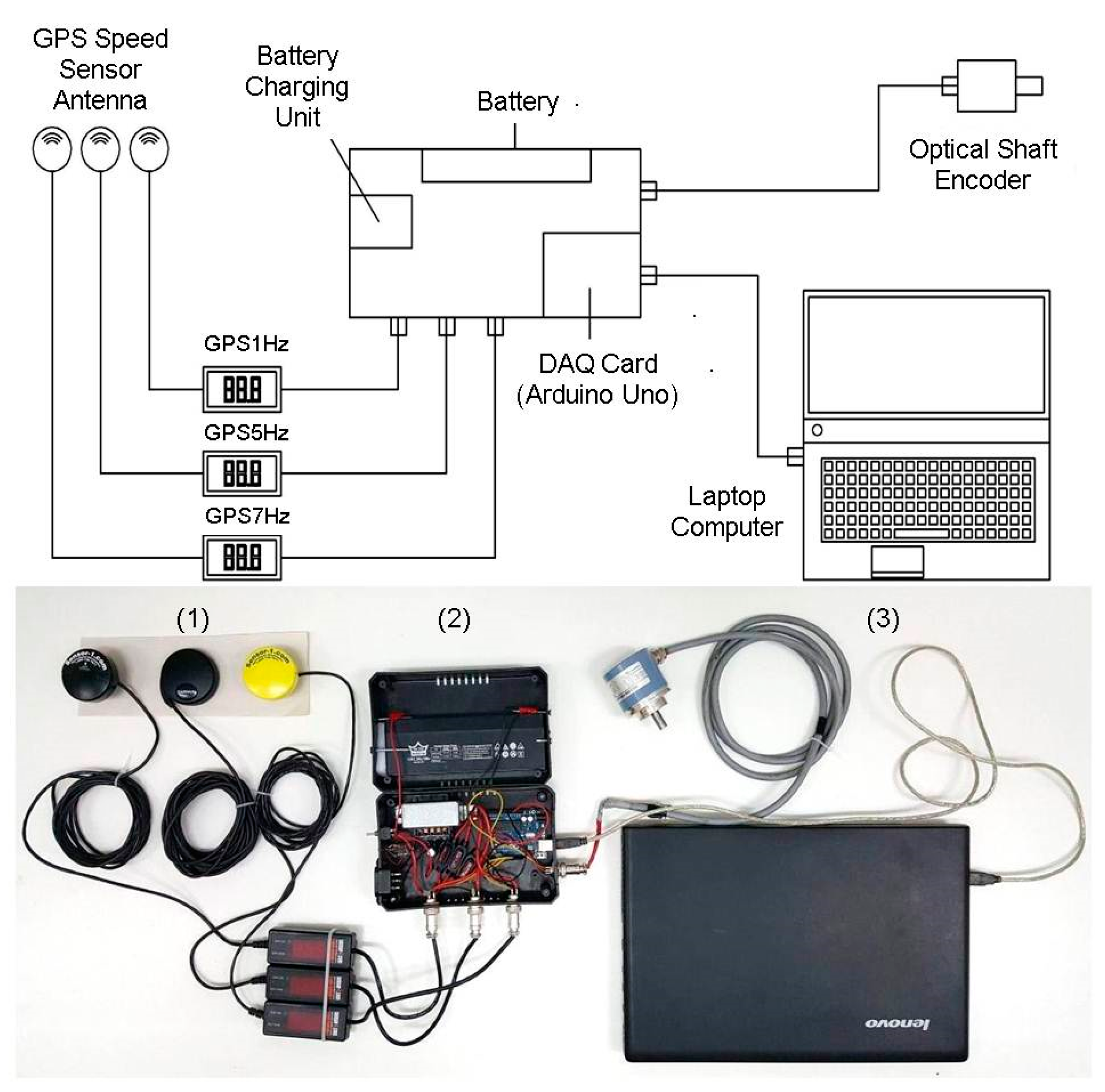

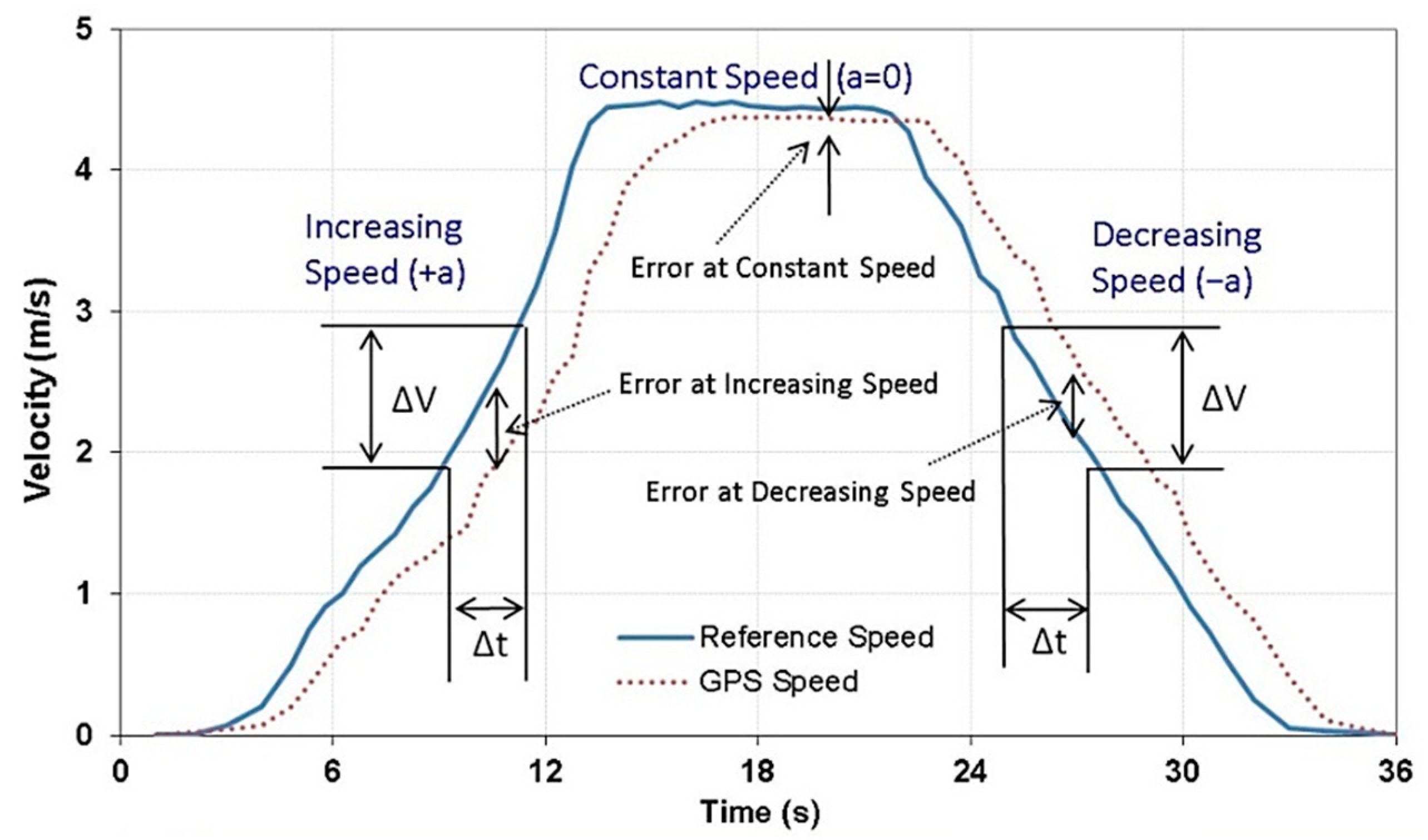

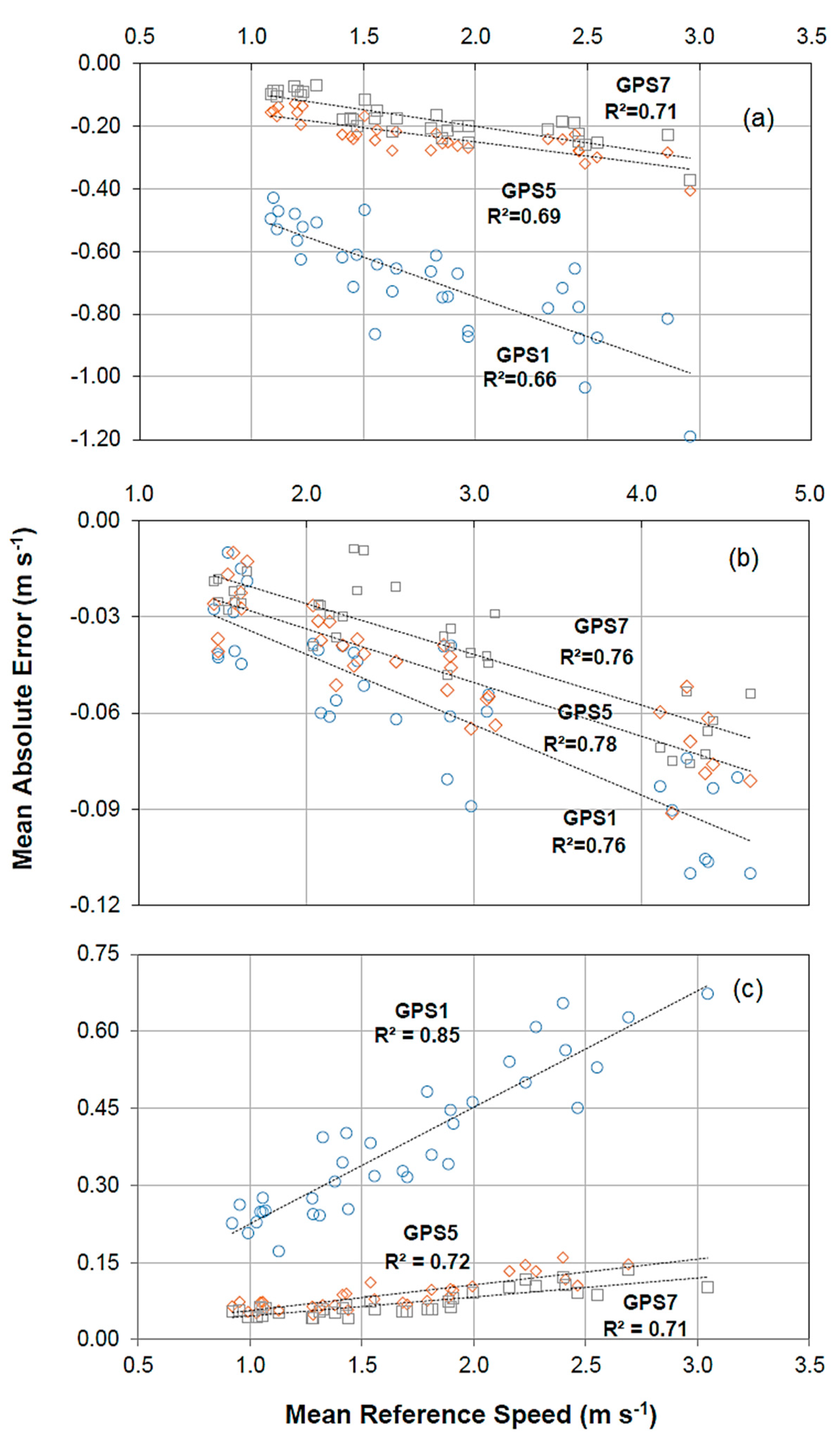
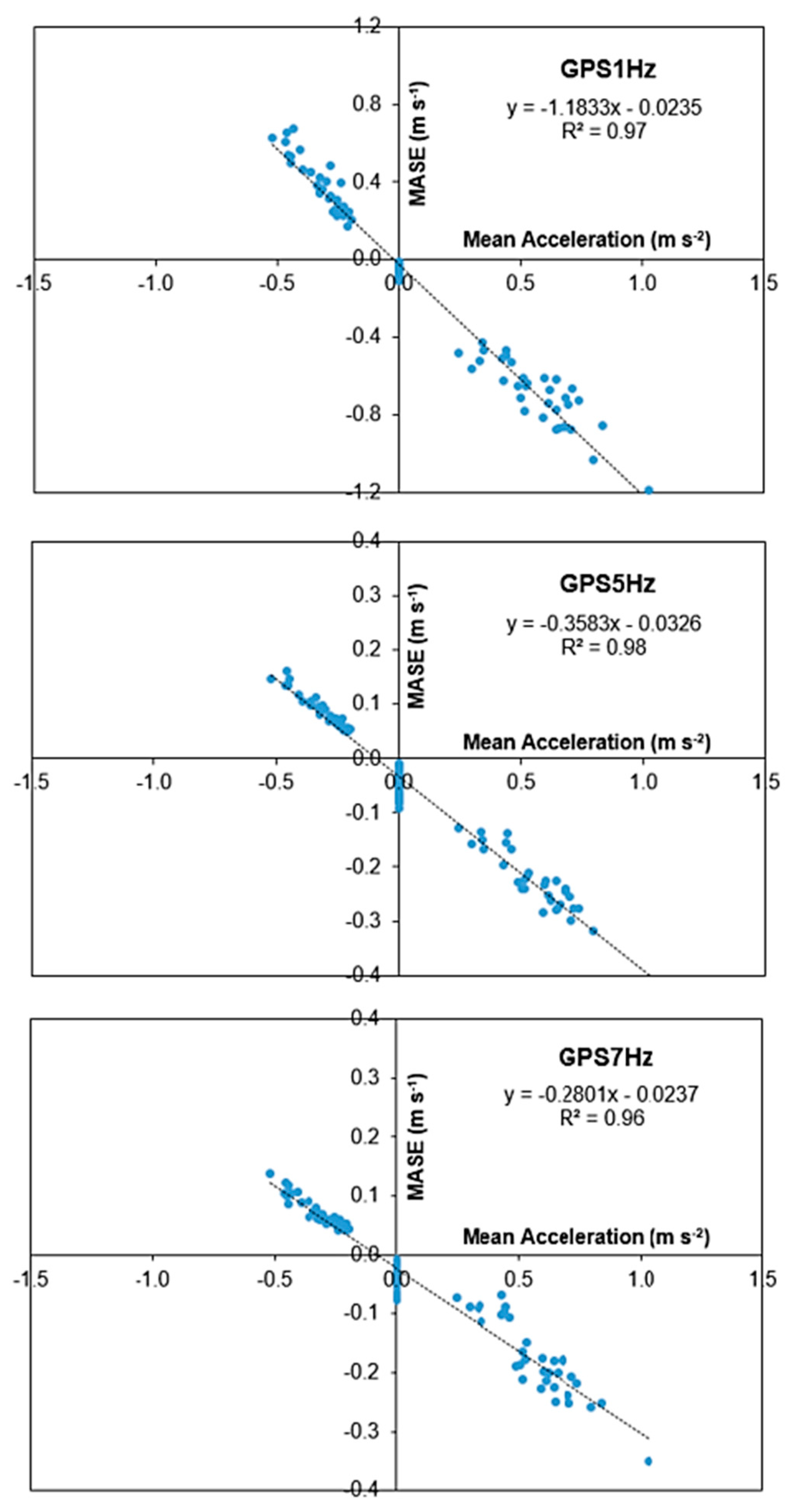
| Device | Make and Model | Technical Features |
|---|---|---|
| GPS1Hz | Sensor-1 GPSMD-1 (Princeton, KS, USA) | Data update frequency: 1 Hz Output signal: 57 Hz mp h−1 Signal type: Square pulse (0–12 V) |
| GPS5Hz | Sensor-1 GPSMD-5 (Princeton, KS, USA) | Data update frequency: 5 Hz Output signal: 57 Hz mp h−1 Signal type: Square pulse (0–12 V) |
| GPS7Hz | Sensor-1 GPSMD-7 (Princeton, KS, USA) | Data update frequency: 7 Hz Output signal: 57 Hz mp h−1 Signal type: Square pulse (0–12 V) |
| Optical Shaft Encoder | Wachendorff WDG 58B-1000 (Geisenheim, Germany) | Power input: 5 VDC Output signal: 1000 Hz/revolution Signal type: Square pulse (0–5 V) |
| DAQ card | Arduino Uno R3 (Somerville, MA, USA) | Power input: 5 VDC (USB) Digital channels: 14 (6 PWM) Analog channels: 6 Memory: 32 KB |
| Criteria | Details of Test Criteria |
|---|---|
| Test days (three days) | 24 April 2018 25 April 2018 26 April 2018 |
| Test times (three times) | Morning (between 9:00 and 11:00) Noon (between 13:00 and 15:00) Evening (between 17:00 and 19:00) |
| Speed levels (four levels) | Gear 1 (~1.40–1.80 m s−1) Gear 2 (~2.00–2.50 m s−1) Gear 3 (~2.70–3.20 m s−1) Gear 4 (~4.30–5.20 m s−1) |
| Number of replications | Four replications at each speed level |
| Total number of tests | 144 (3 days × 3 times × 4 speeds × 4 replications) |
| Day and Time | Weather | Number of Satellites | EHPE * (m) | EVPE * (m) | HDOP * | VDOP * | |
|---|---|---|---|---|---|---|---|
| Day 1 Morning | Partly cloudy | Min: Max: Mean ± SD: | 5 8 6.7 ± 0.54 | 3.2 5.5 3.7 ± 0.46 | 3.5 5.9 4.0 ± 0.42 | 1.1 2.9 1.5 ± 0.38 | 1.0 2.7 1.5 ± 0.47 |
| Day 1 Noon | Partly cloudy | Min: Max: Mean ± SD: | 7 8 7.3 ± 0.22 | 2.8 3.4 3.0 ± 0.18 | 5.1 6.8 5.7 ± 0.50 | 1.4 1.7 1.6 ± 0.10 | 2.0 2.8 2.3 ± 0.17 |
| Day 1 Evening | Clear, sunny | Min: Max: Mean ± SD: | 7 7 7.0 ± 0.01 | 2.6 3.7 2.8 ± 0.29 | 3.8 4.8 4.0 ± 0.22 | 1.0 1.7 1.1 ± 0.09 | 1.3 1.9 1.4 ± 0.10 |
| Day 1 Morning | Partly cloudy | Min: Max: Mean ± SD: | 5 6 5.1 ± 0.24 | 2.6 3.0 2.9 ± 0.07 | 5.4 6.4 5.9 ± 0.26 | 1.3 2.0 1.8 ± 0.12 | 1.0 3.1 1.7 ± 0.62 |
| Day 1 Noon | Partly cloudy | Min: Max: Mean ± SD: | 7 8 7.5 ± 0.50 | 2.7 3.3 3.0 ± 0.18 | 4.3 6.8 5.1 ± 0.79 | 1.1 1.8 1.4 ± 0.19 | 1.4 3.1 2.0 ± 0.43 |
| Day 1 Evening | Partly cloudy | Min: Max: Mean ± SD: | 7 8 7.5 ± 0.50 | 2.3 3.0 2.6 ± 0.26 | 3.4 4.2 3.7 ± 0.31 | 1.1 1.3 1.2 ± 0.05 | 1.7 2.0 1.8 ± 0.08 |
| Day 1 Morning | Clear, sunny | Min: Max: Mean ± SD: | 6 10 8.5 ± 0.90 | 3.0 6.8 3.9 ± 1.08 | 3.0 5.8 3.7 ± 0.77 | 0.8 1.9 1.1 ± 0.36 | 1.1 1.9 1.2 ± 0.23 |
| Day 1 Noon | Clear, sunny | Min: Max: Mean ± SD: | 7 8 7.9 ± 0.32 | 2.5 3.3 2.6 ± 0.17 | 3.7 6.0 4.0 ± 0.29 | 0.9 1.3 1.0 ± 0.08 | 1.1 2.0 1.2 ± 0.14 |
| Day 1 Evening | Clear, sunny | Min: Max: Mean ± SD: | 7 10 7.3 ± 0.49 | 2.4 3.4 2.6 ± 0.27 | 3.4 5.4 3.7 ± 0.44 | 0.9 1.3 1.1 ± 0.11 | 1.2 2.0 1.7 ± 0.28 |
| Acceleration | Speed Level | GPS Speed Sensor | Mean Acceleration (m s−2) | Mean Speed (m s−1) | Mean Absolute Error (m s−1) * | Mean Percent Error (%) * |
|---|---|---|---|---|---|---|
| a = + (Increasing speed conditions) | Gear 1 | GPS1Hz GPS5Hz GPS7Hz | 0.38 | 1.17 | −0.51 ± 0.06 a −0.15 ± 0.02 b −0.09 ± 0.01 c | −42.3 ± 3.61 a −12.8 ± 2.39 b −7.5 ± 1.39c |
| Gear 2 | GPS1Hz GPS5Hz GPS7Hz | 0.63 | 1.50 | −0.66 ± 0.12 a −0.23 ± 0.03 b −0.17 ± 0.03 b | −46.5 ± 9.79 a −15.8 ± 2.44 b −11.5 ± 1.91 b | |
| Gear 3 | GPS1Hz GPS5Hz GPS7Hz | 0.68 | 1.86 | −0.73 ± 0.10 a −0.25 ± 0.02 b −0.21 ± 0.03 b | −40.3 ± 8.16 a −14.4 ± 1.80 b −11.4 ± 1.57 b | |
| Gear 4 | GPS1Hz GPS5Hz GPS7Hz | 0.66 | 2.55 | −0.86 ± 0.16 a −0.29 ± 0.06 b −0.24 ± 0.05 b | −34.3 ± 6.61 a −11.2 ± 1.49 b −9.4 ± 1.60 b | |
| a = 0 (Constant speed conditions) | Gear 1 | GPS1Hz GPS5Hz GPS7Hz | 0 | 1.55 | −0.03 ± 0.01 a −0.03 ± 0.01 a −0.02 ± 0.01 a | −2.0 ± 0.84 a −1.6 ± 0.69 a −1.4 ± 0.26 a |
| Gear 2 | GPS1Hz GPS5Hz GPS7Hz | 0 | 2.18 | −0.05 ± 0.01 a −0.04 ± 0.01 a −0.03 ± 0.01 b | −2.2 ± 0.48 a −1.7 ± 0.32 b −1.2 ± 0.52 c | |
| Gear 3 | GPS1Hz GPS5Hz GPS7Hz | 0 | 2.91 | −0.06 ± 0.02 a −0.05 ± 0.01 a −0.04 ± 0.01 b | −2.3 ± 0.72 a −1.8 ± 0.25 b −1.3 ± 0.28 c | |
| Gear 4 | GPS1Hz GPS5Hz GPS7Hz | 0 | 4.36 | −0.09 ± 0.02 a −0.07 ± 0.01 b −0.07 ± 0.01 b | −2.2 ± 0.42 a −1.5 ± 0.42 b −1.4 ± 0.36 b | |
| a = − (Decreasing speed conditions) | Gear 1 | GPS1Hz GPS5Hz GPS7Hz | −0.24 | 1.03 | 0.24 ± 0.03 a 0.06 ± 0.01 b 0.05 ± 0.01 b | 23.3 ± 3.46 a 6.3 ± 1.02 b 5.3 ± 0.77 b |
| Gear 2 | GPS1Hz GPS5Hz GPS7Hz | −0.26 | 1.38 | 0.31 ± 0.06 a 0.07 ± 0.01 b 0.05 ± 0.01 b | 22.5 ± 4.25 a 5.1 ± 0.83 b 3.9 ± 0.61 b | |
| Gear 3 | GPS1Hz GPS5Hz GPS7Hz | −0.32 | 1.80 | 0.39 ± 0.06 a 0.09 ± 0.02 b 0.07 ± 0.01 b | 22.0 ± 3.07 a 5.0 ± 0.96 b 3.8 ± 0.60 b | |
| Gear 4 | GPS1Hz GPS5Hz GPS7Hz | −0.44 | 2.47 | 0.57 ± 0.07 a 0.13 ± 0.02 b 0.11 ± 0.02 b | 23.6 ± 3.15 a 5.2 ± 1.30 b 4.4 ± 0.73 b |
Publisher’s Note: MDPI stays neutral with regard to jurisdictional claims in published maps and institutional affiliations. |
© 2021 by the authors. Licensee MDPI, Basel, Switzerland. This article is an open access article distributed under the terms and conditions of the Creative Commons Attribution (CC BY) license (https://creativecommons.org/licenses/by/4.0/).
Share and Cite
Akkamis, M.; Keskin, M.; Sekerli, Y.E. Comparative Appraisal of Three Low-Cost GPS Speed Sensors with Different Data Update Frequencies. AgriEngineering 2021, 3, 423-437. https://0-doi-org.brum.beds.ac.uk/10.3390/agriengineering3020028
Akkamis M, Keskin M, Sekerli YE. Comparative Appraisal of Three Low-Cost GPS Speed Sensors with Different Data Update Frequencies. AgriEngineering. 2021; 3(2):423-437. https://0-doi-org.brum.beds.ac.uk/10.3390/agriengineering3020028
Chicago/Turabian StyleAkkamis, Mustafa, Muharrem Keskin, and Yunus Emre Sekerli. 2021. "Comparative Appraisal of Three Low-Cost GPS Speed Sensors with Different Data Update Frequencies" AgriEngineering 3, no. 2: 423-437. https://0-doi-org.brum.beds.ac.uk/10.3390/agriengineering3020028







